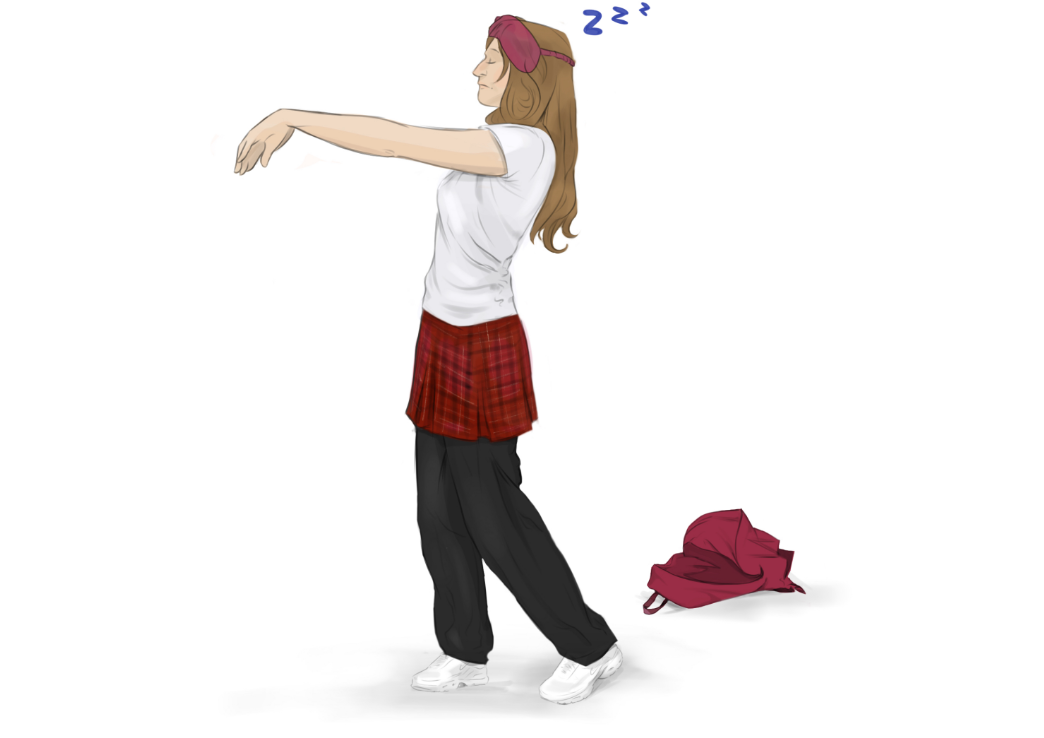It is two in the morning but who needs sleep right? A triple shot of espresso in the morning will do the trick. The impact of sleep loss affects the human brain in a negative manner and can lead to numerous neurological and psychiatric disorders. Major long-term disorders include schizophrenia, Alzheimer’s disease, anxiety disorders, and addiction.
“Students in middle and high school are recommended to regularly sleep 8-10 hours” the Academy of Sleep Medicine says. According to the CDC, about 72.2% of high school students do not get enough sleep on school nights. That is 7 out of 10 students that are potentially experiencing difficulties focusing in class, increased anxiety, and even depression. The American Chemical Society (ACS) reports how sleep deprivation, especially in students, leads to neurological damage in a part of the brain called the hippocampus. The hippocampus is responsible for the use of memory and learning. When students spend hours awake at night working on projects and studying for tests, they increase their risk of memory loss and a more frustrating process when learning. This means burning the midnight oily to get in extra study hours may be giving students the opposite effects.
The National Library of Medicine explains how “when one sleeps, the brain reorganizes and recharges itself, and removes toxic waste byproducts which have accumulated throughout the day.” Sleep can clear the brain and help it to maintain its rational thought. Scientists relate the dangers of chronic sleep loss to sharing qualities of driving when intoxicated. This new evidence is important because it demonstrates that sleeping truly “clears the cobwebs” inside the brain.
In a regular person, sleep is divided into two major phases and then further divided into different cycles. The first phase is non-rapid eye movement or NREM and the second is rapid eye movement also known as REM. The NREM is divided into three stages as a person falls asleep. The three stages are called N1, N2, and N3. The N1 phase is the transitional stage in between wake and sleep. N2 phase is what is known as “light sleep” which takes place throughout the sleep period. During N2, muscles relax, heart rate slows, and the human body temperature drops. The final stage, N3, is called the delta or slow wave sleep; which is classified as a deep sleep.
Studies show that lack of sleep can be detrimental to memory recollection and induce elevated stress levels. Sleep deprivation can cause neurons in the brain to malfunction. This malfunction affects a person negatively causing irrational thoughts and reckless behavior. Certain stages of sleep are needed to form new memories and generate synaptic connections.
As found in a Mayfield Crier Survey with over 200 students reporting, 88% of Mayfield Senior Students find themselves often falling asleep in class and feeling tired at school. 96% of students reported homework being the main cause for preventing girls getting enough sleep. 69% reported extracurriculars causing sleep deprivation, 64% reported stress, and 48% claimed technology and social media prevented them from getting a good night’s rest.
Julianna Aparicio ’25, a junior at Mayfield Senior School notes a typical active high school to be the cause. Aparicio claims she gets about four to five hours of sleep per night during the school week.
“On a good day I will go to bed at 12:30 to 1:00 a.m,” she said. Aparicio explained that during her week she has rehearsals from 5:30 p.m. to 7:30 p.m. after school and on Mondays and Wednesdays she has double rehearsals which go from 3:15 p.m. to 4:15 p.m. and then 5:30 p.m. to 7:30 p.m. again. “It’s just a lot of my day so I barely have time to do homework until 9 o’clock.”
Many students also responded that before bed they use technology and social media. “I try to carve out 15 minutes to watch a show or scroll through TikTok but then once my time is up it’s hard to go to bed because I feel like I haven’t gotten a break all day so I want to unwind” Aparicio said. “Sometimes I’m so stressed about school and assessments that I feel like I’m not even fully getting sleep because half my mind is awake panicking.” Aparicio confessed she has experienced awful migraines and stomach aches because of her lack of sleep and even blurry vision at certain times of the day due to exhaustion.
Mayfield Senior School begins at 8:00 a.m. and many of its students have expressed their unhappiness with the start time. Teenagers from ages 13-18 have been proven to need more sleep than what they are getting and far less than the. Recommended 8-10 hours per night.
Students at Mayfield on average have gotten 5-6 hours during the school week. Teachers and other adults may claim “well look at how much they sleep over the weekend” and “they can catch up on sleep during breaks”. Making up those lost hours on a weekend isn’t the answer. weekend Harvard health claims that “weekend catch-up sleep won’t fix the effects of sleep-deprivation”. When a person attempts to “catch-up” on lost sleep it takes extra time for the human body to fully recover. The National Library of Medicine declared one hour of lost sleep takes a human a full four days to recover. If a student begins their Monday with 10 hours of sleep but loses an hour every night from studying or homework or stress, then by Friday they will need 20 days to fully recover. “I really wish that I could sleep more because then I know my entire report card would improve,” says Isa Schmid, class of 2025.



